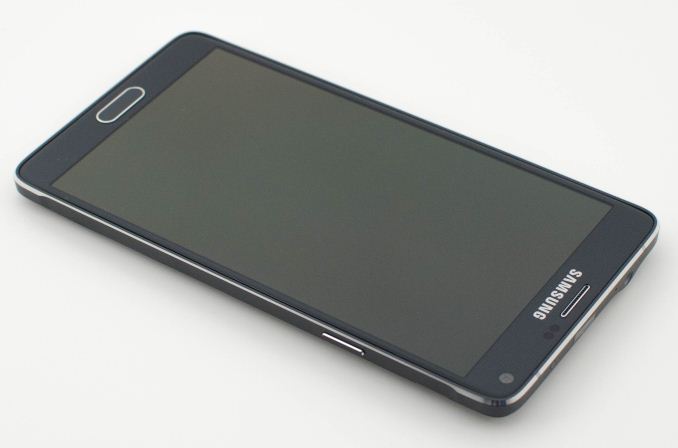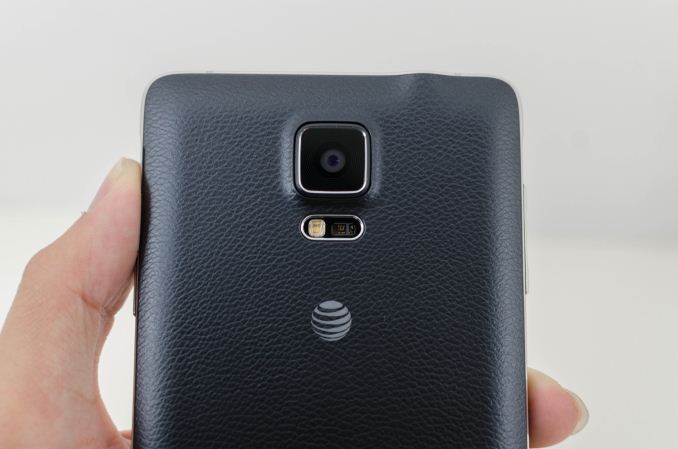The Samsung Galaxy Note 4 Review
by Joshua Ho on October 15, 2014 9:00 AM EST- Posted in
- Smartphones
- Samsung
- Android
- Mobile
- Galaxy Note 4
Final Words
The Galaxy Note 4 builds on the Galaxy S5 and Galaxy S5 LTE-A, but there’s still a lot to go over. We’ll break this down by section before coming to any real conclusions about this device. Based upon my time with the Galaxy Note 4, it’s clear to me that the most critical point of differentiation in the Galaxy Note 4 is the software experience. While other phones with TouchWiz can have similar features, it’s really a function of the hardware and additional feature support that comes with the Note 4 that makes the Galaxy Note more than just a big phone. The good news here is that Samsung continues to have a lot of great ideas in software, and many of the features tend to be quite helpful in nature. However, there’s a need to polish these features as the implementation tends to be rough around the edges. Overall, one shouldn’t have any significant issues with the software but Apple definitely has an edge in the polish department, even if the functionality isn’t as extensive.
The next key distinction is the display. The Galaxy Note is differentiated by its software, but defined by its display. It’s definitely big, and should be great for media consumption with its high contrast. More importantly, Samsung has continued to push better display calibration, brightness, and other areas where AMOLED was previously deficient. While there are still some issues with purple smearing and green tints to some level of grayscale, the AMOLED display is an equal to the 1080p display in the iPhone 6 Plus.
While the display defines the Galaxy Note 4 as a phablet, the design of the device itself is also important. To this end, Samsung has finally delivered a phone that feels as premium as its competition. While I do have some minor nitpicks regarding the design, on the whole it really is good enough that I don't have any real complaints. There are definitely phones and phablets out there that look and feel better, but the gap isn't large enough that it would count against the Note 4. The move to a unibody design would also mean that there wouldn't be a removable battery or microSD slot, which likely isn't worth the cost to Samsung in key markets like Korea that have a great need for both of those features.
While not quite as defining as the display, battery life is often one of the main draws of a larger phone. In this department, the Galaxy Note 4 does provide a level of improvement when compared to the Galaxy S5, but the higher resolution of the display means that battery life will slightly trail behind the iPhone 6 Plus. Despite this, no one should really have any issues getting a full day of use out of the Note 4. The adaptive fast charger also means that the Note 4 should be able to have better real-world battery life in scenarios where charge time is critical.
Finally, while unrelated to the formfactor itself, the Galaxy Note 4’s OIS has significant implications for low light performance and video quality. In practice Samsung’s OIS solution has a large accommodation angle and works well, although the use of OIS is closer to continuous rather in limited situations like on the iPhone 6 Plus. The use of OIS also makes it possible to go from the rather poor low light experience that we saw with the Galaxy S5 to a competitive one in the Note 4. While it isn't quite as good as the iPhone 6 Plus in low light, it makes up for it with higher resolution for daytime photography and similar situations where the 1.1 micron pixels aren't really a limitation.
We can talk more about the SoC performance, but at this point Snapdragon 805 is a known quantity. Instead, it's more important to talk about the Galaxy Note 4 as a whole, and on the whole Samsung continues to define the phablet segment with their features. For that alone, Samsung deserves praise as they continue to innovate in this space. If this innovation was also implemented with high levels of polish, I would have little issue calling the Galaxy Note 4 the best phablet on the market. As-is, the Galaxy Note 4 remains one of the best phablets on the market, but whether it's the best for a given user is a matter of priorities and personal preference rather than any absolutes.














195 Comments
View All Comments
xype - Thursday, October 16, 2014 - link
Uh, huh, haha, you are teh funnay.It _is_ ugly, actually. Plenty of better looking Android devices out there. I don’t know why tech writers need to even add stuff like "design massively improved", when it’s actually not _massively_ improved.
And, no, I don’t think the iPhone 6 is massively improved design-wise (though it looks better from the front than anything Samsung offers), either.
And design is not subjective and open to interpretation. If it was, people wouldn’t be able to agree on a "best design", ever, because the type of looks people liked would be evenly divided among all kinds of designs. And there would be no rules on how to make things look good, either. Just because companies like Samsung don’t understand them it doesn’t mean that those don’t exist.
Tams80 - Thursday, October 16, 2014 - link
People don't agree on 'best design ever'. Well a small group of self congratulatory can, but such a group have often lost touch with reality.theduckofdeath - Thursday, October 16, 2014 - link
You're shooting yourself in the foot if you're arguing that design is not subjective, as Samsung sell 300 million smartphones every year, all of them tends to follow the design language of their current flagship device. So....?tralalalalalala40 - Friday, October 17, 2014 - link
They are giving phones away. Consumers like that, and Samsung is only helping google ironically. Seen their profit's this quarter?solipsism - Wednesday, October 15, 2014 - link
So the Note 4 is thicker, header, only a 32GB only, and USB 3.0 replaced with USB 2.0 over the Note 3? Am I reading that properly?theduckofdeath - Wednesday, October 15, 2014 - link
Probably not, because we don't know what you mean by header. :DThe phone will also come with 64GB storage and it supports SD storage at 128GB and 256GB when that size is in the stores.
The shift back to USB 2 is probably a pretty smart one, as the larger USB 3 connector isn't very convenient.
melgross - Wednesday, October 15, 2014 - link
Using the USB 3 connector wouldn't allow you to make phone calls, among other problems. They had to get rid of it. I can't understand why testing didn't show that.NZtechfreak - Saturday, October 18, 2014 - link
I didn't wait for 256gb micro SD, using a full size 256gb SD in my Note 3 (modified wooden case and ribbon adapter). So, if you must have that right now you can. I'm mulling over whether to get the 512gb SD card and stay with my Note 3 until my contact renews and then grab a Note 4 or something else...rpg1966 - Wednesday, October 15, 2014 - link
"...every GPS fix is a hot fix and takes around 5 seconds" and "...I saw that it took around 50 seconds to achieve a lock".I'm sure I'm being a bit thick, but what does this mean? The initial lock is ~50s, then ~5s thereafter?
JoshHo - Wednesday, October 15, 2014 - link
The initial lock is 50s only if you deliberately clear assistance data (or it expires after a few days of non-use) with airplane mode on. Otherwise it should be less than 10-15 seconds.